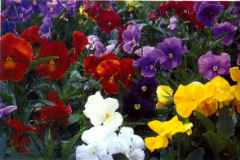 |
For The Fall |
 |
For The Fall |
Last week we spoke of mums and asters for fall color and I promised to speak more on the subject this week. I will address members of the cabbage family, pansies, snapdragons, and fall flowering Camellias. With the exception of the camellias, these plants have an extended bloom period, unlike the mums and asters.
First, the cabbage family (Brassica) has plants which are known for their colorful foliage. They offer no bloom but a wide array of color including red, violet, purple, pink, white, and varying shades of green. You may choose from flowering kale, flowering cabbage, and "peacock" kale. The ruffled, colorful foliage intensifies as the weather gets cooler with the occurrence of frost actually elevating the color to its greatest intensity level. On rare occasions of a mild winter, these plants will actually last through the spring before subsiding the head of late spring. For a period in the early 1990's the flowering Brassica actually exceeded mums in popularity because of a longer color season. This trend seems to have reversed itself because colorful foliage is still no match for the brilliance of the short-lived mum blossom.
Pansies are members of the Viola family. They are "winter annuals" meaning the easily survive the winter and are killed by the head of the summer. Pansies come in a wide array of brilliant colors and serve as the "stand in" for annual beds during the winter. Summer annuals give color from May through September. Pansies give color from October through April, often times profusely blooming into early May and it's tempting to let them grow. Ultimately the summer head will give them a "ratty" appearance or kill them out. If you wait for this decline, vacant beds may occur due to the lack of availability of summer annuals, or you may miss a large portion of your summer annual bloom due to late planting. As much as you hate to do this, remove the pansies in early May and replace them with something more suitable. In fall of 1995 I planted pansies in above ground planters at my children's daycare center. This was the winter of multiple ice storms. In mid March of 1996, the pansies were blooming like crazy, enduring the ice nicely!
Snapdragons are a hardy annual which often survives the winter. I plant them in the fall and take my chances. My snapdragons did great this past winter of 1999 (having been planted in late November of 1999) and have bloomed all summer. Assuming these plants survive the coming winter, they should be spectacular. If you can plant in October and survive the winter, spring bloom is phenomenal. It's worth the risk!
Camellia sasanqua is the fall flowering camellia which is opening as we speak. While the late winter, early spring Camellia japonica has a larger flower, the Sasanqua is hardier and does provide blossom for the fall. The thick, dark green, glossy leaves make this evergreen shrub a wonderful addition to the landscape. The plant grows 4 to 6 feet high in a conical shape. Though Camellia sasanqua is hardier than Camellia japonica, I would plant it in a protected area such as corner, since Camellias are marginally hardy through Zone 7. In a nasty winter such as the ice storm year of 1995-1996, Camellias were killed to the ground, however, they returned from the root with great vigor. Hope your fall is bright and beautiful.
Andy Lynn